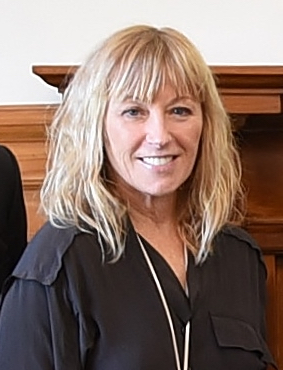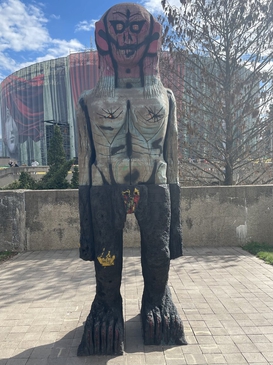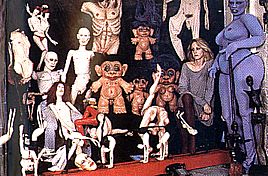
The School of the Museum of Fine Arts at Tufts University is the art school of Tufts University, a private research university in Boston, Massachusetts. It offers undergraduate and graduate degrees dedicated to the visual arts.

Cynthia Morris Sherman is an American artist whose work consists primarily of photographic self-portraits, depicting herself in many different contexts and as various imagined characters.
Joanne Greenbaum is an American artist, known for her abstract paintings and small sculptures. She is based in New York City, and has previously worked in Neukölln in Berlin.

Stephanie Syjuco, is a Filipino-American conceptual artist and educator. Born in the Philippines, she moved to the San Francisco Bay Area in 1977. Syjuco received her MFA from Stanford University in 2005, and BFA in Sculpture from the San Francisco Art Institute in 1995. She currently lives and works in Oakland, California.

Huma Bhabha is a Pakistani-American sculptor based in Poughkeepsie, New York. Known for her uniquely grotesque, figurative forms that often appear dissected or dismembered, Bhabha often uses found materials in her sculptures, including styrofoam, cork, rubber, paper, wire, and clay. She occasionally incorporates objects given to her by other people into her artwork. Many of these sculptures are also cast in bronze. She is equally prolific in her works on paper, creating vivid pastel drawings, eerie photographic collages, and haunting print editions.
Katy Grannan is an American photographer and filmmaker. She made the feature-length film, The Nine. Her work is held in the collections of the Metropolitan Museum of Art, Museum of Modern Art, Solomon R. Guggenheim Museum, and Whitney Museum of American Art.

Greer Lankton, was an American artist known for creating lifelike sewn dolls that were often modeled on friends or celebrities and posed in elaborate theatrical settings. She was a key figure in the East Village art scene of the 1980s in New York.

Rosalyn Drexler is an American visual artist, novelist, Obie Award-winning playwright, and Emmy Award-winning screenwriter, and former professional wrestler. Although she has had a polymathic career, Drexler is perhaps best known for her pop art paintings and as the author of the novelization of the film Rocky, under the pseudonym Julia Sorel. Drexler currently lives and works in New York City, New York.
Lois Dodd is an American painter. Dodd was a key member of New York's postwar art scene. She played a large part and was involved in the wave of modern artists including Alex Katz and Yvonne Jacquette who explored the coast of Maine in the latter half of the 20th century.
Laurie Simmons is an American artist, photographer and filmmaker. Since the mid-1970s, Simmons has staged scenes for her camera with dolls, ventriloquist dummies, objects on legs, and people, to create photographs that reference domestic scenes. She is part of The Pictures Generation, a name given to a group of artists who came to prominence in the 1970s. The Pictures Generation also includes Cindy Sherman, Barbara Kruger, and Louise Lawler.
Agnes Denes is a Hungarian-born American conceptual artist based in New York. She is known for works in a wide range of media—from poetry and philosophical writings to extremely detailed drawings, sculptures, and iconic land art works, such as Wheatfield — A Confrontation (1982), a two-acre field of wheat in downtown Manhattan, commissioned by the Public Art Fund, and Tree Mountain—A Living Time Capsule (1992–96) in Ylöjärvi, Finland. Her work Rice/Tree/Burial with Time Capsule (1968–79) is recognized as one of the earliest examples of ecological art. She lives and works in New York City.
Squeak Carnwath is an American contemporary painter and arts educator. She is a professor emerita of art at the University of California, Berkeley. She has a studio in Oakland, California, where she has lived and worked since 1970.

Barbara Takenaga is an American artist known for swirling, abstract paintings that have been described as psychedelic and cosmic, as well as scientific, due to their highly detailed, obsessive patterning. She gained wide recognition in the 2000s, as critics such as David Cohen and Kenneth Baker placed her among a leading edge of artists renewing abstraction with paintings that emphasized visual beauty and excess, meticulous technique, and optical effects. Her work suggests possibilities that range from imagined landscapes and aerial maps to astronomical and meteorological phenomena to microscopic views of cells, aquatic creatures or mineral cross-sections. In a 2018 review, The New Yorker described Takenaga as "an abstractionist with a mystic’s interest in how the ecstatic can emerge from the laborious."
Samara Golden is an American artist based in Los Angeles.
Garrett Bradley is an American filmmaker and director of short films, feature films, documentaries, and television. She is known for blending cinematic genres to explore the larger sociopolitical significance of the everyday moments of her subjects' lived experience.

Joanna Pousette-Dart is an American abstract artist, based in New York City. She is best known for her distinctive shaped-canvas paintings, which typically consist of two or three stacked, curved-edge planes whose arrangements—from slightly precarious to nested—convey a sense of momentary balance with the potential to rock, tilt or slip. She overlays the planes with meandering, variable arabesque lines that delineate interior shapes and contours, often echoing the curves of the supports. Her work draws on diverse inspirations, including the landscapes of the American Southwest, Islamic, Mozarabic and Catalan art, Chinese landscape painting and calligraphy, and Mayan art, as well as early and mid-20th-century modernism. Critic John Yau writes that her shaped canvasses explore "the meeting place between abstraction and landscape, quietly expanding on the work of predecessors", through a combination of personal geometry and linear structure that creates "a sense of constant and latent movement."

Harriet Korman is an American abstract painter based in New York City, who first gained attention in the early 1970s. She is known for work that embraces improvisation and experimentation within a framework of self-imposed limitations that include simplicity of means, purity of color, and a strict rejection of allusion, illusion, naturalistic light and space, or other translations of reality. Writer John Yau describes Korman as "a pure abstract artist, one who doesn’t rely on a visual hook, cultural association, or anything that smacks of essentialization or the spiritual," a position he suggests few post-Warhol painters have taken. While Korman's work may suggest early twentieth-century abstraction, critics such as Roberta Smith locate its roots among a cohort of early-1970s women artists who sought to reinvent painting using strategies from Process Art, then most associated with sculpture, installation art and performance. Since the 1990s, critics and curators have championed this early work as unjustifiably neglected by a male-dominated 1970s art market and deserving of rediscovery.
Lana Lin is a filmmaker, artist, and scholar based in New York City. Since the early 1990s, she has made experimental films, videos, and documentaries that examine the politics of identity and cultural translation, informed by the poetic and conceptual qualities of moving image media.
Betsy Kaufman is a visual artist based in New York known for abstract paintings and works on paper, as well as needlepoint sculptures. Critics distinguish her work by its subversion of modernist systems and its insertion of strong emotion, humor, and narrative into geometric abstraction. Writer Ingrid Schaffner observed that Kaufman's paintings are "inherently based on disruption … She has made the accidents, oppositions, contradictions, and mercurialness, which most organizing impulses work hard to minimize, into the rationale that guides the unpredictable and forceful narrative of her abstractions." Kaufman has exhibited at the Brooklyn Museum, Musée d’art moderne de Saint-Etienne (France), Queens Museum of Art, Staatsgalerie Stuttgart (Germany) and the Tang Museum, among other venues.

Susan Chen is an artist and painter in New York City. Her portrait paintings survey communities, exploring topics on identity, the psychology of race, and social change.










